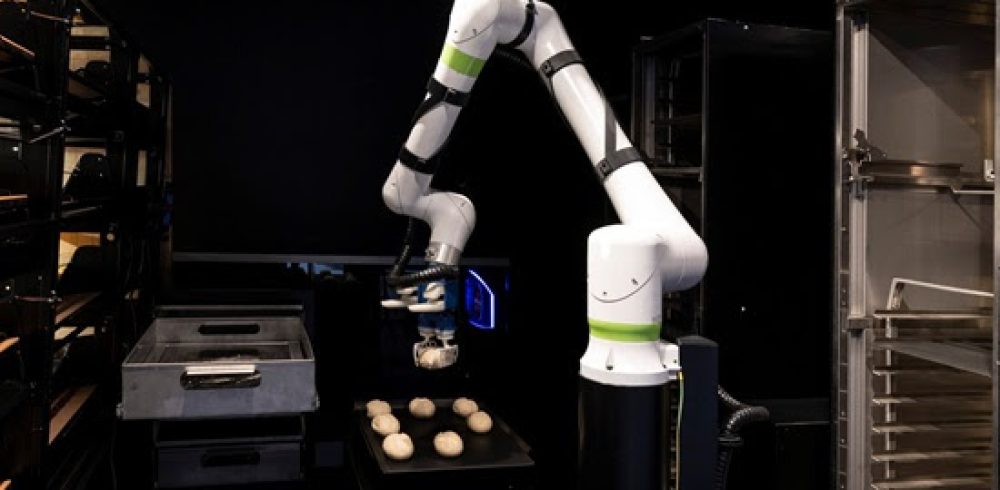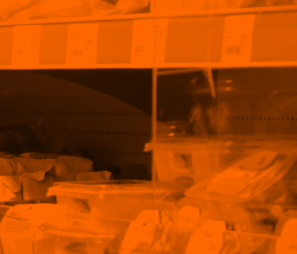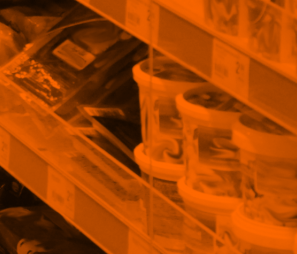FANUC has joined forces with baking oven manufacturer WIESHEU and retail specialist Wanzl to develop the automatic Bakisto system.
For decades, robots have been helping to increase production efficiency, improve quality and consistency, and alleviate labour shortages in industries such as automotive, machinery, and plastics. Other sectors however, including food and beverage, have been slower to wake up to the benefits of automation, with many food producers still heavily reliant on manual labour and semi-automated equipment. Figures from the IFR 2022 World Robotics Industrial Robots Report show that only 3% of global industrial robot installations are for food and beverage applications, compared with 23% for automotive. Fortunately, the tide is beginning to turn – global robot installations in the food and beverage industry grew by 12% year on year from 2016 to 2021. And in the UK, of the 2,054 industrial robot installations in 2021, 164 were in the food and beverage industry, representing a total of 8% – well above the global average.
Most robot installations in food production lines are for packaging, picking and placing tasks. However, there is a lot more that robots can do. At FANUC, we believe the adoption of robotics is set to change the face of food manufacturing for the better, both for primary and secondary processing and packaging tasks. Here, we look at four ways in which food production lines could look very different thanks to the increased use of robots and automation…
1 Increased use of cobots
Lightweight and simple to use, collaborative robots, or cobots, are becoming increasingly popular within food factories, especially where space is restricted. Extremely slimline and with a base not much bigger than an A4 sheet of paper, they fit easily into crowded areas, such as loading/palletising environments, and can work alongside humans. Despite their size, they lend themselves well to lifting applications, such as palletising and material handling tasks – the FANUC CRX-25iA, for example, has a 25kg payload and a 1,889mm reach. We are continuing to develop our cobot range and in the future, we expect to see cobots with increasingly high payloads and longer reaches, to cope with growing customer demand.
2 Less manual handling
Since Covid and Brexit, labour shortages in the food industry have worsened and companies are looking to remove manual handling wherever possible. While a number of the individual processes in a food factory may already be automated, in many cases, people are still required to move products from one stage to another. Robots are ideally placed to help in these scenarios. Inherently flexible, they can easily be repurposed to cope with product changes enabling the factory to remain agile in the face of labour shortages.
Packing is another area which is traditionally very labour intensive. There is now a clear trend of using robots to pack ingredients into trays, trays into boxes and boxes onto pallets, freeing up human workers to carry out more value-added tasks. In the future, food factories will resemble automotive factories more and more, with robots carrying out the majority of manual handling tasks. There will also be an increased use of autonomous robot vehicles to move stock around the warehouse, and for loading/unloading.
3 AI-powered vision inspection systems
Another area which is ripe for automating is quality control. Robotic vision inspection systems using AI and machine learning can detect product faults quickly, accurately and reliably, helping to speed up production lines. This technology can also be used for product sorting and grading, eg potatoes. Repetitive, manual tasks such as this are ideal for being completed by AI-powered vision-guided robots, helping to free up valuable human employees.
4 Robots in the field
Finally, robots are moving out of the factory and helping to replace labour shortages in the fields. There are already trials of robots being placed onto tractors and incorporated with a vision system to inspect produce in the field. They can assess the stage of growth/ripeness, and then pick the fruit or vegetable when they’re ready to be harvested. Expect to see many more of these applications in the future.
Automation in action: Meet Bakisto, the robot baker
FANUC has joined forces with baking oven manufacturer WIESHEU and retail specialist Wanzl to develop the automatic Bakisto system. Comprising three interconnected systems – a FANUC cobot; Wanzl’s smart baked goods presenter ‘BakeOff i’ featuring artificial intelligence and a network-enabled baking oven; and the WIESHEU TrayMotion automatic loading and unloading system – Bakisto automates important tasks for retail bakeries, such as loading baking trays, inserting and removing trays from the oven, and restocking displays.
Based on historical data and current stock levels, the AI-powered BakeOff i estimates daily baked goods demand and predicts when peak baking should take place. The FANUC cobot then carries the baking trays loaded with frozen baked goods from the refrigeration unit and pushes them into the transport trolley, which runs on rails in front of the preheated oven. The TrayMotion loading system pulls in the loaded trays, enabling the baking process to begin. After baking, the system pushes the baking trays back into the transport trolley, which moves to the side, allowing the baked goods to cool down while also making space for subsequent production. The FANUC cobot then fills the predefined compartments of the BakeOff i with the finished and cooled baked goods. Feeding new data into the AI system ensures the process is continuously being optimised.
FANUC believes that Bakisto is ripe for addressing labour shortages in the food industry by relieving retail workers from repetitive tasks and unsociable working hours, as well as increasing product consistency and reducing food waste.
Manufacturing & Engineering Magazine | The Home of Manufacturing Industry News















